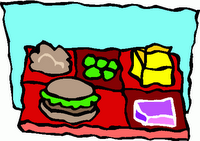School Lunches Get Healthy...maybe
 I applaud this effort before my kids make it to full-time school - it's about time. Remember that horrific mac and cheese that acted like glue when you smooshed in your milk carton and turned the tray upside down to see if it stuck? Schools are promising to keep closer tabs on student lunch trays, pull sugary treats from vending machines and classroom celebrations and encourage more pulse-raising activities during the school day. The nation's public schools are under orders to adopt nutrition and exercise goals before classes resume in the fall. The written wellness policies are required by a federal law that took effect July 1.
I applaud this effort before my kids make it to full-time school - it's about time. Remember that horrific mac and cheese that acted like glue when you smooshed in your milk carton and turned the tray upside down to see if it stuck? Schools are promising to keep closer tabs on student lunch trays, pull sugary treats from vending machines and classroom celebrations and encourage more pulse-raising activities during the school day. The nation's public schools are under orders to adopt nutrition and exercise goals before classes resume in the fall. The written wellness policies are required by a federal law that took effect July 1. "Some school districts and school buildings have already made a lot of these changes and some have done nothing just because they've never been required to," said Alicia Moag-Stahlberg, executive director of Action for Healthy Kids, a 50-state nonprofit network. "Frankly, schools that have never had this conversation are having it."
The law's primary objective is straightforward: combating rising childhood obesity rates. Overweight children miss more school than their average weight counterparts, according to the National School Boards Association. Backers also argue that reducing sugar in students' diets leads to greater focus in the classroom. Some states are making similar efforts through new laws and policies, and the federal law gives school boards wide latitude, causing vast differences in their approaches.
In Tennessee's Williamson County, for instance, the broadly worded policy runs 23 lines; in Hampton, New Hampshire, the five-page plan is so detailed it suggests elementary students have "at least two colors other than white and brown as part of their lunch meal." Committees comprised of administrators, teachers, parents and students are looking well beyond the cafeteria for ways to promote healthier eating habits and more physical activity.
In St. Paul, students will find water, fruit juice and milk in vending machines that used to dispense soda. In Farmington, Utah, schools are holding recess before lunch so kids don't give short shrift to their meals in the race to the playground. Teachers in Cape Girardeau, Missouri, will encounter restrictions on goodies they can give out in their classrooms. Lollipops and sodas will be no-nos. Rhonda Dunham, a principal at an elementary school in the district, will try other rewards for students who meet homework goals or display good behavior. One plan is to set up elegant lunches, where kids get specially prepared meals at tables with linen cloths, china and glassware. "They feel a bit more grownup that way," she said. Classroom candy also has lost favor in the northwestern Minnesota district of Perham Dent. "The truth is, one Jolly Rancher isn't bad, but 13 years of several Jolly Ranchers a day is a bad habit to learn," said superintendent Tamara Uselman. Her district is incorporating more movement into the school day as well. One geography teacher is setting up stations in her classroom so students are on the move every 20 minutes.
Many school districts are making clear that recess is valuable exercise time and shouldn't be withheld as punishment.
While school leaders and health advocates generally laud the law's intent, concerns do exist. Congress didn't give schools money to implement the policies or offer compensation for the potential loss of vending sales proceeds. An Illinois education panel noted another barrier: Schools have difficulty setting aside time from their other pressing priorities such as the federal No Child Left Behind law, which carries consequences if students don't show progress in core subjects.
The wellness directive requires school districts to measure progress but doesn't contain consequences for those that don't live up to the law. "I don't think the federal government put enough teeth into this," Dunham, the elementary principal, said. "We are accountable basically only to ourselves. In some school districts, I could see this going by the wayside."
And don't expect the wellness policies to, um, bear fruit overnight. "It's like eating an elephant," said Brenda Greene, the National School Board Association's director of school health programs. "You need to do it one bite at a time."
Source - AP



1 Comments:
The problem here starts way before grade school. It starts in the home, as the family meal time has all but disappeared. Parents have allowed themselves to become short order cooks or spend their evening at the mall food court. We also see kids in daycare sitting down for breakfast with burger king, microwave pancakes, and donuts. We are still amazed that parents can justify such behavior and then wonder why our nation's kids are getting larger, lazier, and dumber - relying more on quick, convienent, and easy options...learning next to nothing along with way.
It is nice to see school's changing but kids will not change unless parents get back to cooking dinners and packing lunches that do not come in a fast food chain paper bags.
Jeff
http://www.outwiththekids.com
Post a Comment
<< Home